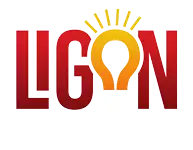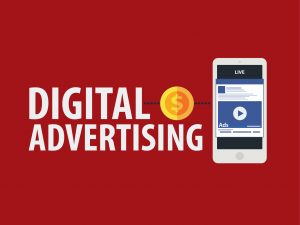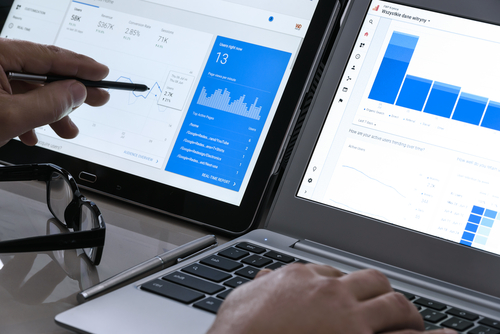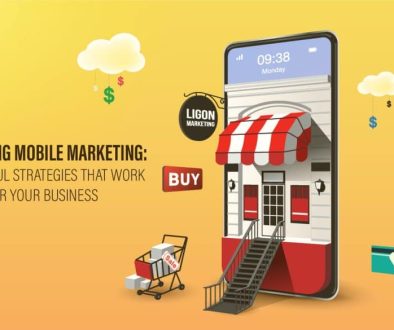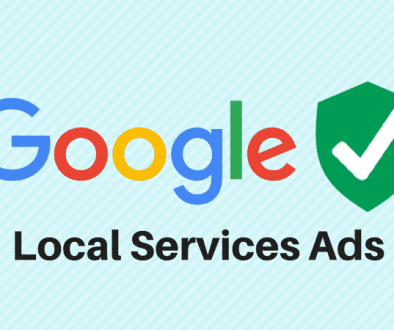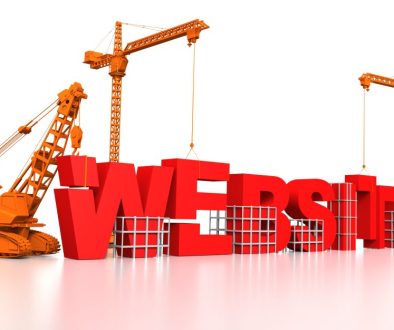Digital Advertising Part 1: What Is Digital Advertising and Why Do I Want It?
In the digital-first era, if your business doesn’t have a strong presence online, then your brand isn’t being seen. And if your business isn’t advertising online, then your brand isn’t staying competitive. This year, market research company eMarketer predicts that digital’s share of total advertising spend will near 50% globally, and soon digital ad spending will surpass traditional mediums.
The rapid rise of producing and distributing promotional content via digital channels (like search engines, social media, mobile apps, emails, and third-party websites) isn’t surprising. First and foremost, online is where your consumers are. Second, advertisers have discovered that digital advertising is vastly more data-driven, measurable and precise than many traditional mediums. And third, digital ads are cost-effective, drive new qualified leads, increase brand awareness and deliver an impressive return on investment (ROI).
“And third, digital ads are cost-effective, drive new qualified leads, increase brand awareness and deliver an impressive return on investment (ROI).”
To boil it all down: digital advertising is a bandwagon your business needs to be jumping on. At Ligon Marketing, we specialize in digital advertising and paid search marketing services. We’re here to help businesses navigate the complex ins-and-outs of advertising online. This blog article is the first in a multi-part series covering all the essentials of digital ads and paid search.
So let’s dive right in – keep reading as we guide you through the basics of what digital ads are and the types of online advertising available.
What Do I Get Out of Digital Advertising?
We’re not saying that traditional advertising isn’t effective – executed correctly, it is. The stages of the buyer’s journey haven’t changed; however, many consumers are completing the entire buyer’s journey through online touchpoints. To meet this new shift, digital advertising offers several unique benefits over traditional mediums.
-
Brand awareness. For your campaigns to be effective, your marketing efforts need to reach consumers where they are. And in 2021 and moving forward, the vast majority of your audience is online. Having a digital presence is crucial to increasing brand visibility and reach.
-
Measurable results. Traditional forms of advertising (print, TV, radio, billboards, direct mail) don’t offer you a way to measure the effectiveness or ROI of your ads. Digital ads can be tracked and monitored from start to finish with ad platforms automatically collecting and documenting the data.
-
Selective targeting. In the same vein as the point listed above, traditional print or TV advertising may not allow you to target the exact audience you’re trying to reach. Digital advertising offers several valuable targeting options for audience demographics, including age, location, interests, behaviors, past purchasing decisions, income, education and more. Selective targeting ensures that your budget is going toward the consumers most likely to take action after seeing your ad.
-
Testing. Digital advertising provides testing capabilities that allow you to continuously gather information on the types of ads that are effective. With A/B testing, you can run two ads simultaneously while varying one aspect. Such as the audience targeting or the ad image to determine which ad performs better. Once you determine the audience taking the most actions and the ad copy or images generating the most engagement, you can weed out ineffective strategies and optimize future ads for better results.
-
Real-time optimization. Once your print ad or TV commercial is out in the world, the messaging, ad copy and graphics are locked in until the campaign is complete. And if the messaging doesn’t resonate with consumers, then your business has wasted time and resources on an ineffective campaign. In contrast, the flexibility of digital advertising allows you to optimize ads in real-time as you track the metrics and ad performance. If a Facebook ad is performing poorly after one week of a 4-week ad run, you can alter it. You can easily adjust the ad copy, image or audience targeting to draw more engagement without overextending your budget.
-
Wider reach. Digital advertising allows you to advertise to and engage with consumers at every stage of the buyer’s journey, from awareness through the purchasing decision. Your business can optimize ads for different audience specifications or keyword searches that reach consumers at multiple touchpoints along the buyer’s path.
-
Instant results. Don’t misunderstand us – organic SEO is an incredibly effective strategy for driving traffic to your website, generating quality leads and growing your business. But SEO takes time to make a positive impact and produce results. Digital advertising immediately puts your brand and offerings in front of potential customers. On the backend, you can track ad performance in real-time to determine the impact your efforts have.
-
Customized budget. Digital advertising flips the balance of control. For traditional print, TV or radio ads, the publisher sets the budget your business must fulfill to guarantee ad space. In contrast, digital advertising allows you to control how much you spend to produce ads. Also, how much you end up paying based on ad performance (we’ll get into the specifics later in this article). Digital advertising is customizable and scalable for businesses of all sizes.
Still on board? Then let’s look at the ad options available for your business.
5 Types of Digital Ads
Digital platforms allow for a diverse offering of ad types and layouts. The following are the 5 most popular ad formats.
-
Search engines. Search engine marketing (SEM) displays advertisements at the top of search engine result pages (SERPs). SEM is a great way to put your brand in front of consumers searching for relevant keywords and phrases surrounding your business offerings. Google dominates in search engine ads – with over 3.5 billion searches being processed per day, Google ads marketing offers the largest and most diverse audiences for businesses to target.
-
Social media. Facebook, Instagram, Twitter, LinkedIn and Pinterest all offer advertising space, and with over 3.6 billion people using social media worldwide, social platforms are the place to be. Social media is also a fantastic place to showcase engaging, eye-catching video or image-based ads.
-
Display. Display ads are advertisements that appear on third-party websites or apps affiliated with search engines and ad networks. Many websites also directly sell advertising space to advertisers. Display ads can be an effective component of a remarketing campaign. Advertisers have a bounty of choices for displaying ads through banners, popups, video, text, mobile or images. Like with SEM, Google dominates in the world of display ads. The Google Display Network contains millions of websites and mobile apps that reach 90% of internet users, including user-rich YouTube.
-
Native. Native advertising uses ads that match the look and feel of the media platform where they’re displayed. What does that mean? Native ads don’t really look like ads – they might look like advertorials, “recommended articles,” or “promoted content” on social media and websites. They make a soft sell that exposes users to advertising in a non-disruptive way. Native ads can be quite effective for attracting users who are wary of being advertised to and have “ad blindness,” where they scroll past obvious ad content without reading it.
-
Remarketing. Remarketing displays your ads to consumers who have already visited your website or taken an action but haven’t taken further steps to convert. The purpose of remarketing is to keep your brand top of mind for consumers and re-engage them into the conversion process.
Now you may be wondering: what types of ads are right for my business needs? Ad selection is a whole article in itself, so we’re going to cover the topic in more detail in the second part of our blog series – be on the lookout for that in the next few weeks! For now, let’s talk about how payments for ads are determined.
Bidding Models for Digital Ads
Your business has a lot of control over how you pay for digital advertisements. The most popular bidding models for ads include:
-
Pay-per-click (PPC). PPC is exactly what it sounds like: your business pays for every click on your ad. The appeal of PPC is that users who click on an ad are more likely to take an action on your website and convert. The resulting sale would be far more profitable than what you paid for the click. PPC is the most common bidding model in SEM.
-
Cost-per-thousand-impressions (CPM). Again, CPM is precisely what the name implies: your business pays for every thousand times your ad is displayed on someone’s screen. CPM is a good bidding model for expanding brand reach, but it’s not cost-effective if users aren’t taking actions on your ads. Simply put, views doesn’t always translate to conversions.
-
Cost-per-action (CPA). If you bid with CPA, your business pays for every conversion that results from your ad. An action could be a click, a sale or a form submission. CPA can be extremely beneficial, since users who take an action on your ad are more likely to convert to a sale.
For more specific ads, your business can also bid by paying for app installs, followers on social media, new connections on LinkedIn, or video views for video ads.
Metrics and Measurables
One of the primary advantages of digital advertising is the ability to track and measure in real-time. Monitoring and analyzing ad metrics helps you improve strategies, optimize ads and decide on next steps to meet your goals. The following metrics can help you gain a high-level understanding of how well your ads are performing.
 Reach is the number of people who saw your ad.
Reach is the number of people who saw your ad.
Impressions are the number of times your ad was displayed on someone’s screen. (*keep in mind that this number includes people who saw your ad multiple times*)
Clicks are the number of times someone clicked on your ad.
Conversions are the number of people who completed the action you set on your ad. (like filling out a form or signing up for a newsletter)
For a more in-depth look at how effective your digital ad strategies are, we will help you monitor the following:
-
Click-through-rate (CTR). CTR is determined by calculating the percentage of clicks to impressions. For example, if your ad got 3 clicks out of 100 impressions, your CTR is 3%. A higher CTR indicates that your ad is relevant, compelling, and resonating with your target audience.
-
Cost-per-click (CPC). CPC is the amount of money your business pays for every click. The CPC is determined by maximum bid for the ad, ad quality and ad competition. Your goal is to have the lowest CPC that’s driving the best traffic and generating quality leads.
-
Cost-per-conversion. Cost-per-conversion is determined by dividing the total cost of an ad by the total number of conversions. The lower cost-per-conversion, the better.
-
Return on ad spend (ROAS). ROAS is determined by calculating the amount of revenue generated from an ad campaign versus the costs to run the campaign. ROAS looks specifically at the effectiveness of ad campaigns to help you determine if digital advertising is a good investment.
OK, I’m Interested – How Do I Get Started?
Hopefully this article got you fired up to start your own digital advertising campaigns or at least piqued your interest. There’s a lot that goes into starting, running and fine-tuning successful ad campaigns:
-
Determining what types of ads will help you meet your business goals
-
Choosing a bidding model
-
Setting a budget
-
Performing market research on buyer personas and target audiences
-
Crafting compelling, engaging ad copy, images and video
-
Monitoring and tracking metrics
-
Optimizing ads in real-time to improve performance
Sound time consuming? It is. That’s why we highly recommend seeking help from an experienced digital advertising and PPC services company like Ligon Marketing. From start to finish, our team will help you create and launch an ad strategy that will help you meet your business goals. Call us today at 863-838-5475 or drop us a message online.
